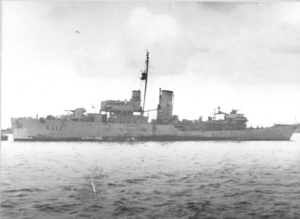
The “Flower” Class Corvette, HMCS MATAPEDIA, was laid down on 2 February 1940 in the yards of Morton Engineering and Dry Dock Company, Quebec, P.Q., launched on 14 September of the same year and commissioned on 9 May 1941. The ship was named after a community in Bonaventure County, Quebec, at the confluence of the Matapedia and Restigouche Rivers, near the head of the Bay of Chaleur. The name is a Micmac word meaning “forked river.”
After reaching Halifax, MATAPEDIA began to escort convoys between that port and Sydney, N.S. From November she turned to accompanying as far east as Iceland the slow SC convoys which formed up at Sydney. On her returning voyages, she escorted convoys which had originated in the United Kingdom. When, in early 1942, Londonderry, Northern Ireland, became the eastern terminus of the mid-ocean escorts, she was one of the first Canadian corvettes to enter the port.
In April 1942 she transferred to the Halifax Force and began then to escort ships only in local waters. In May of the following year, she became a member of Group W-5 in the Western Local Escort Force. She continued to operate in local waters, accompanying convoys to Newfoundland and down the United States seaboard to Boston and New York. An October 1943 press release on her reported that she had completed “more than 100,000 miles of convoy work without having a ship torpedoed or lost.” A freighter, it is true, which she had been escorting, was torpedoed and sunk, but it had been straggling at the time, having fallen eighteen miles astern of the convoy at night and in a dense fog. Thus its loss was not recorded against her.
The press release noted also that she had weathered storms which had almost swamped her. One of them smashed the bridge and shattered the windows of the wheelhouse. Another broke up the bridge a second time and gave her no rest for ten days. Despite this, she was the only ship in her escort to come through with part of the convoy, the rest having turned back for shelter.
In September 1943, off Halifax, the ship was involved in a collision with the 4800-ton British freighter, SS Scorton. MATAPEDIA had to be towed first to Dartmouth, then to Liverpool, N.S., where repairs and refitting held her until March 1944. In April of that year she was transferred to Group W-4 in the Western Local Escort Force. Another Liverpool refit, followed by the usual “working-up” exercise period off Bermuda, kept MATAPEDIA out of action from February 1945 to the end of the war.
To prepare her for disposal, she was sailed from the islands to Sydney in May. Following her arrival on the 31st, she began to land ammunition and reduce the numbers in her ship’s company. Then she steamed to Sorel, P.Q. On 16 June 1945, HMCS MATAPEDIA paid off and was turned over to War Assets Corporation. Frankel Brothers, Toronto, bought her, but sold her to the Victory Transport and Salvage Co. Ltd. of Montreal for scrap.
 CFB Esquimalt Naval and Military Museum
CFB Esquimalt Naval and Military Museum
 CFB Esquimalt Naval and Military Museum
CFB Esquimalt Naval and Military Museum CFB Esquimalt Naval and Military Museum
CFB Esquimalt Naval and Military Museum CFB Esquimalt Naval and Military Museum
CFB Esquimalt Naval and Military Museum CFB Esquimalt Naval and Military Museum
CFB Esquimalt Naval and Military Museum CFB Esquimalt Naval and Military Museum
CFB Esquimalt Naval and Military Museum CFB Esquimalt Naval and Military Museum
CFB Esquimalt Naval and Military Museum CFB Esquimalt Naval and Military Museum
CFB Esquimalt Naval and Military Museum CFB Esquimalt Naval and Military Museum
CFB Esquimalt Naval and Military Museum CFB Esquimalt Naval and Military Museum
CFB Esquimalt Naval and Military Museum CFB Esquimalt Naval and Military Museum
CFB Esquimalt Naval and Military Museum CFB Esquimalt Naval and Military Museum
CFB Esquimalt Naval and Military Museum
 CFB Esquimalt Naval and Military Museum
CFB Esquimalt Naval and Military Museum CFB Esquimalt Naval and Military Museum
CFB Esquimalt Naval and Military Museum CFB Esquimalt Naval and Military Museum
CFB Esquimalt Naval and Military Museum CFB Esquimalt Naval and Military Museum
CFB Esquimalt Naval and Military Museum CFB Esquimalt Naval and Military Museum
CFB Esquimalt Naval and Military Museum CFB Esquimalt Naval and Military Museum
CFB Esquimalt Naval and Military Museum CFB Esquimalt Naval and Military Museum
CFB Esquimalt Naval and Military Museum CFB Esquimalt Naval and Military Museum
CFB Esquimalt Naval and Military Museum CFB Esquimalt Naval and Military Museum
CFB Esquimalt Naval and Military Museum CFB Esquimalt Naval and Military Museum
CFB Esquimalt Naval and Military Museum

 CFB Esquimalt Naval and Military Museum
CFB Esquimalt Naval and Military Museum CFB Esquimalt Naval and Military Museum
CFB Esquimalt Naval and Military Museum CFB Esquimalt Naval and Military Museum
CFB Esquimalt Naval and Military Museum CFB Esquimalt Naval and Military Museum
CFB Esquimalt Naval and Military Museum CFB Esquimalt Naval and Military Museum
CFB Esquimalt Naval and Military Museum
 CFB Esquimalt Naval and Military Museum
CFB Esquimalt Naval and Military Museum



 CFB Esquimalt Naval and Military Museum
CFB Esquimalt Naval and Military Museum
























 CFB Esquimalt Naval and Military Museum
CFB Esquimalt Naval and Military Museum CFB Esquimalt Naval and Military Museum
CFB Esquimalt Naval and Military Museum
 CFB Esquimalt Naval and Military Museum
CFB Esquimalt Naval and Military Museum